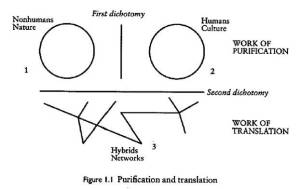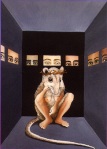Review of Cori Hayden’s When Nature Goes Public: Bioprospecting in Mexico (2003)
My purpose is to track the ways in which a host of political liabilities and property claims, accountabilities and social relations are being actively written into routine scientific practices, tools and objections of invention and back out again… I see the key task for science studies in this context as one of analyzing how such relations are being activated and fashioned in articulation with neoliberal modes of participation – for a wide range of actors, including scientists and their rural and indigenous interlocutors. (29)
In her ethnographic mapping of the complicated exchanges and debates of bioprospecting in Mexico, Cori Hayden continually presses the point that bioprospecting incorporates nature, transforming it into a commercial enterprise. “Nature,” she states, “is one of the many things that has increasingly been treated, by development agencies, national governments in the North and South, organizations regulating global trade, and some conservationists, as a public good best regulated and managed through market mechanism” (48). She also makes the point that in this capitalization of nature individuals are also regulated and managed by being delegated roles, responsibilities, and financial rewards. Scientists and rural populations are drafted to expedite the extraction of plant samples with the ultimate goal of developing commercial drugs and pesticides. Government officials are similarly drafted to facilitate possible bioprospecting sites by doing such things as negotiating trade agreements, creating regulations and zoning laws that would be favorable to the industry, providing the necessary infrastructure such as building roads and power lines to remote areas, and encouraging venture capital from the private sector by providing financial incentives in the form of grants and tax credits. As a result of this concerted effort, the commerce of bioprospecting and everyday life for many Mexicans has become much more entrenched. As Hayden explains, this epistemic shift is not limited to rural Mexico but is part of a much broader shift that manifested with the rise of neoliberalism. The neoliberal agenda espoused by the Reagan and Thatcher governments in the 1980s has become predominant to the extent that not only has nature been transformed into a source of capital, but all of life has been similarly refashioned. In this shift biology, specifically molecular biology, has assumed a place of great importance. The biochemical process of synthesizing molecular compounds found in plants is seen as an effective way to develop pharmaceuticals and other products and is being herald as both a lucrative and sustainable model of economic development that is socially and environmentally responsible. Echoing Marilyn Strathern and Donna Haraway, Hayden refers to this neoliberal revision of life and microbiology as a matter of “enterprising up” (27).
What sets Hayden’s text apart from other critiques of neoliberalism and the capitalization of nature is her refusal to represent bioprospecting in Mexico as a well-defined ethical debate. Instead, she insists on the muddiness of bioprospecting, its ambiguous twist and turns, its aspirations and fears, its promises and setbacks. Rather than attempt to summarize the intricacies of Hayden ethnography, I want to focus on aspects of her methodology as a way to highlight some of the recurring aims of science studies. Alongside these aims I also want to flesh out possible shortcomings. Early on Hayden reminds readers that one of basic principles of science studies is the idea “that (scientific) knowledge does not simply represent (in the sense of depict) ‘nature,’ but it also represents (in the political sense) the ‘social interests’ of the people and the institutions that have become wrapped up in its production” (21). In other words, science brings politics to life, as it constitutes one of the main cultural forms/forums in which ideological values and norms manifests. Science studies in turn intervenes by tracing the political lines of thought that run through scientific knowledge. For Hayden’s project this is a matter of charting the flow of “Mexican plants and knowledge from the countryside and rural communities to the sprawling campus of UNAM in Mexico City; from UNAM to U.S. corporations and the University of Arizona; from these U.S. sites back to various agencies, institutes, and communities in Mexico” (10). By charting this flow, Hayden literally reveals some the geopolitics of science in action.
One of the ways Hayden can be seen as intervening in bioprospecting is to spend considerable time in the field observing how the necessary science and relationships are produced. The ethnographic demands lengthy periods of time spent observing your subject firsthand. Hayden’s ethnographic approach can be understood as a means of slowing down bioprospecting’s normal flow of plants and information. It is important to the political and financial success of bioprospecting that there is the appearance of a relatively smooth and consistent series of exchanges in which all the various parties are being treated fairly and efficiently. By being present on a daily bases with the plant-gathering teams, Hayden is in effect able to slowly dissect the various nodes in the bioprospecting network. This way of working coincides with Bruno Latour’s claim that slowness is one of the main strengths of Actor Network Theory or ANT. The ANT scholar, he declares, “prefers to travel slowly, on small roads, on foot, and by paying the full cost of any displacement out of its own pocket.” Latour argues that adopting this slow-paced approach (what he also refers to as a “slowciology”) allows the actors that make up a given network to speak for themselves. “The reason for this change of tempo,” Latour continues, “is that, instead of taking a reasonable position and imposing some order beforehand, ANT claims to be able to find order much better after having let the actors deploy the full range of controversies in which they are immersed.”1 So-called “reasonable positions” are the very thing the slow-moving ANT scholar tries to dispel. Accordingly, Hayden, for the most part, allows her interlocutors (the scientists, the plant venders, the rural community members) to speak for themselves, which results in a story of bioprospecting that is full of abrupt complications and contradictions.
One of the main things Hayden discovers during her extensive time in the field is that the UNAM scientists have found channels to gather samples and traditional knowledge without necessarily compensating local and indigenous communities or individuals. While as an observer on the UNAM plant-gathering trips Hayden witnesses how the public domain (in the form of public markets, publications, and roadways) is utilized as an effective way to avoid the messy issue of property rights. As the scientists explain, they are not doing this solely as a matter of convenience, but because it is next to impossible to determine who owns either the plants in question or the traditional knowledge associated with the plants. This ambiguity illustrates how the neoliberal strategy of establishing patents and intellectual property rights does not work in the favor of the local and indigenous communities. The plant venders in the markets are the only local people directly compensated for selling their wares. Here science seems to working to extend the patenting interests of the U.S. companies financing aspects of the project, while the questions of local and indigenous ownership are to a large degree being ignored. The situation also underscores the fact that for many indigenous people living in rural Mexico, the idea of owning plants and intellectual property totally contradicts their view of the world. Again, bioprospecting is as much a channel for the trafficking and expanding the ideals of neoliberalism, as it is a channel from for the flow of plant extracts.
While having access to these plant-gathering trips allows Hayden to witness science in action and to establish contacts with venders who serve as her main interlocutors, it also places her in a compromising position. Because the venders and other people she encounters came to associate her with UNAM’s bioprospecting project, she found herself at times acting as the project’s spokesperson. As such, Hayden is faced with the question if she was intervening in the flow of bioprospecting or facilitating it.2 To this end, she states in her introduction:
As many critical accounts of ethnographic work have suggested in other context, the very act of trying to “follow the networks” often makes us party to their materialization… Many scientists and activists with whom I spoke in Mexico in the early years of my research had not heard much about the UNAM prospecting project, if anything at all – a situation that implicitly made me the projects “representative” in many interviews. (13)
Hayden does not directly address this anxiety of the ethnographer being co-opted or incorporated into the flow of bioprospecting in the main body of her text, but it is always present, as readers are constantly reminded of how dependent she is on the cooperation of the UNAM scientists. However, despite this anxiety, Hayden still manages to give voice to the concerns and interests of the UNAM scientist along with her other interlocutors and still present a slow, critical version of bioprospecting that completely contradicts the polished neoliberal narrative of letting the free market establish fair competition and proper/reasonable forms of social and environmental development.
Footnotes:
1. Bruno Latour. 2005. Reassembing the Social: An Introduction to Actor-Network Theory. Oxford University Press. p. 23.
2. Adriana Petryna expresses a similar anxiety of being co-opted by the Ukranian medical apparatus in her ethnography, Life Exposed: Biological Citizens after Chernobyl. For a review of this text please see below.






